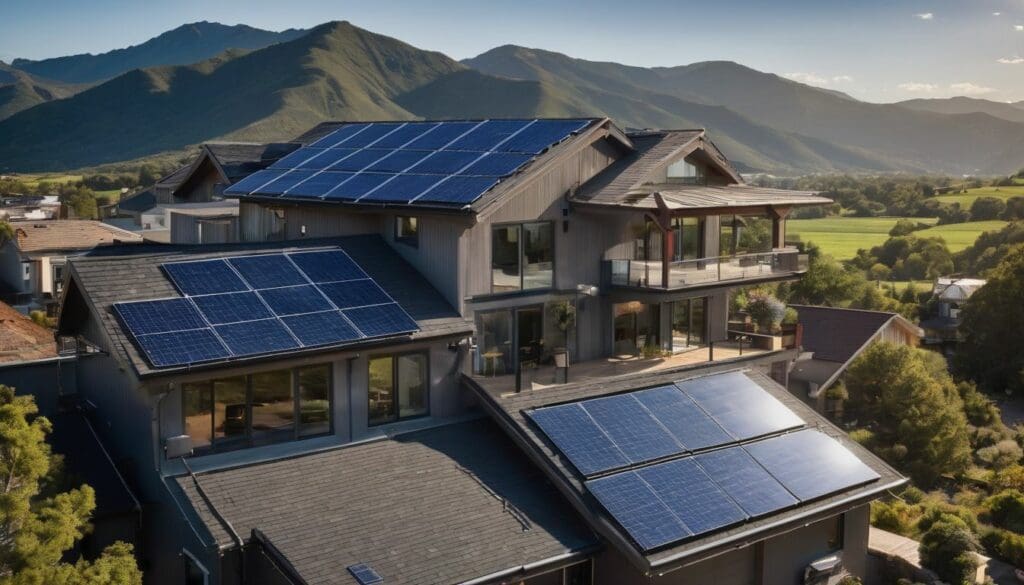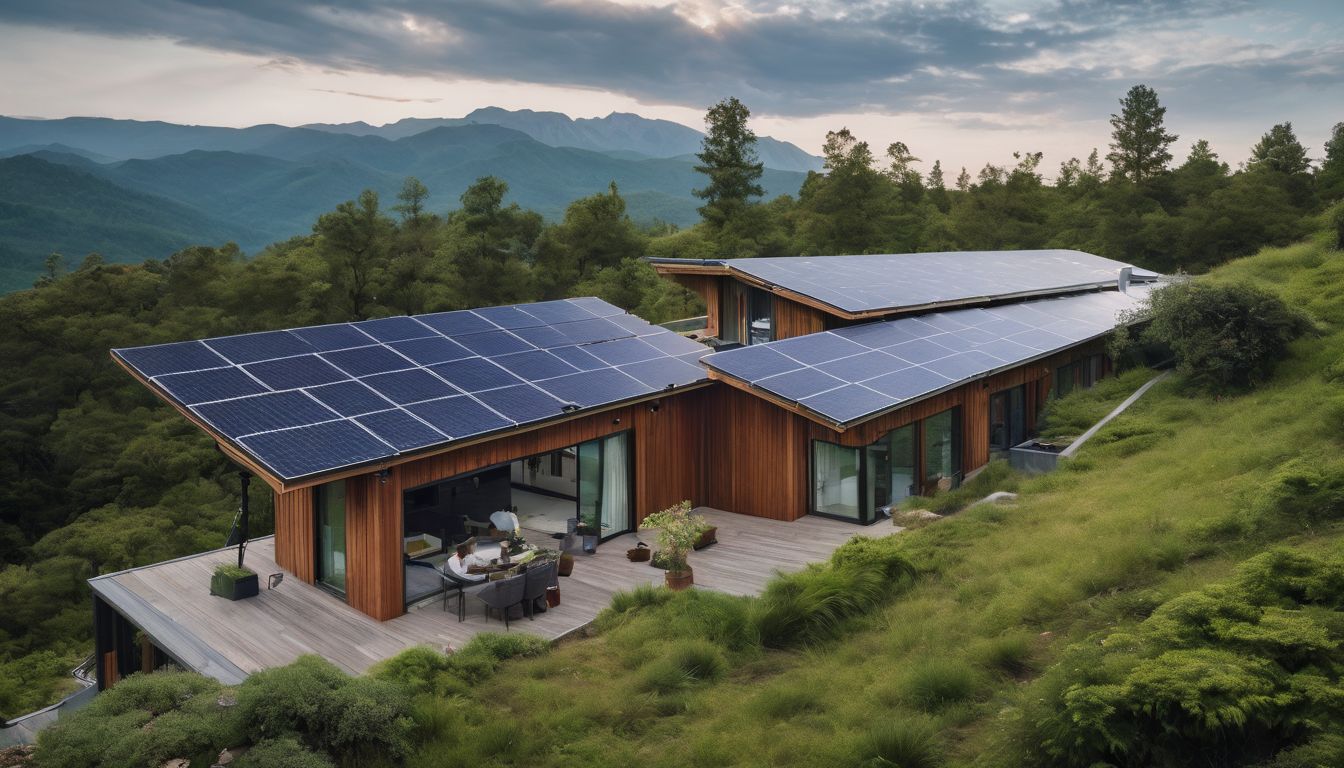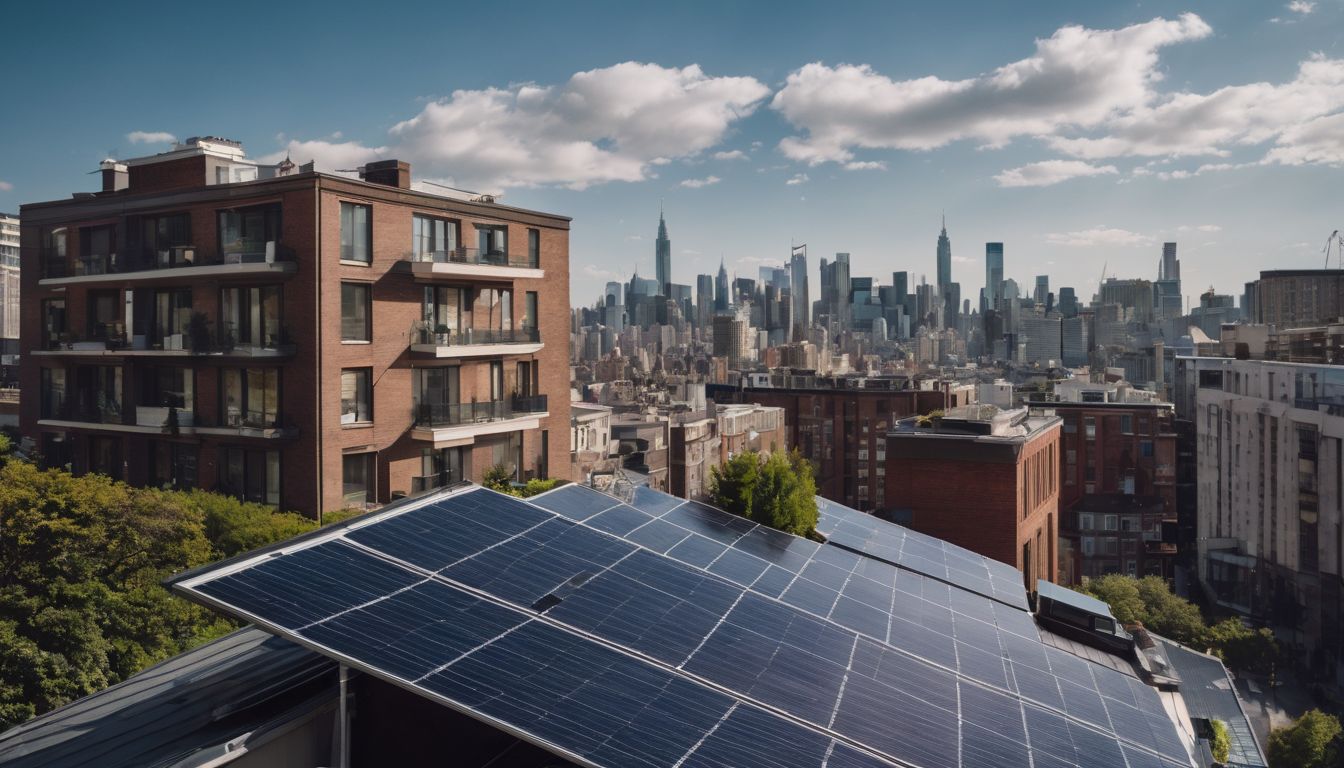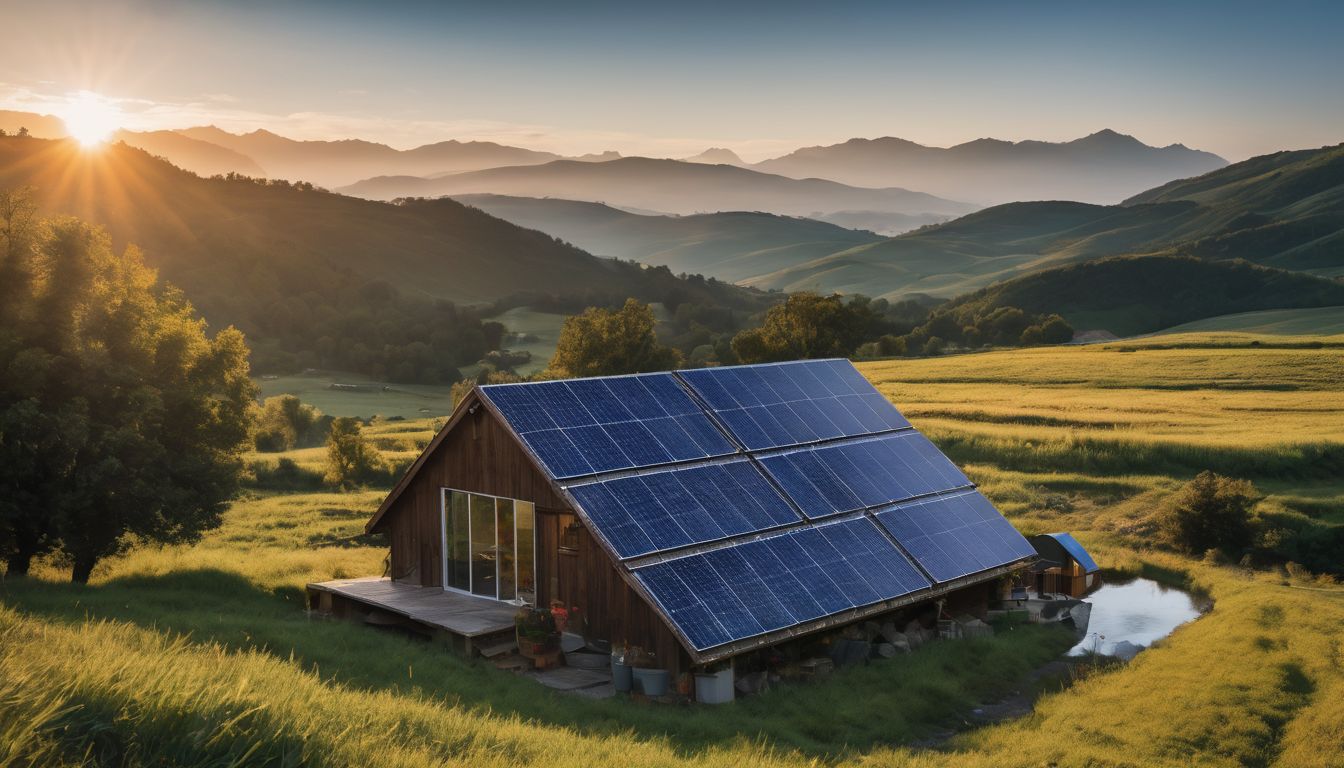Struggling to understand your solar energy needs? Solar power is revolutionising how we harness energy, slashing bills and carbon footprints alike. This article will guide you through the simple steps of calculating your specific solar requirements to make a smart, eco-friendly shift.
Let’s shine a light on solar savings!
Key Takeaways
- To calculate your solar energy needs, start by gathering electricity bills to work out the total number of kilowatt-hours (kWh) you use. Then divide this figure by days and hours to find your hourly energy requirement.
- Consider how factors like peak sunlight hours and production ratios in your area will affect the efficiency of your solar panels. Use online resources or local expert advice to determine these important details.
- Use a solar power calculator, inputting your average kWh usage along with location specifics, to estimate the size and wattage of the solar panel system you’ll need for your home.
- Remember that different sized homes have unique solar panel requirements based on available roof space, energy consumption patterns, and sunlight exposure. Tailor calculations accordingly for accurate results.
- Take into account cost considerations such as type of panels chosen, system size, installation fees, additional equipment needed and ongoing maintenance when planning for a switch to a solar-powered home.
Understanding Your Energy Needs
To effectively calculate your solar energy needs, it’s important to first understand your hourly and yearly energy requirements. This involves calculating your current energy usage and taking into consideration any potential future changes in consumption.
Calculating your hourly energy requirement
Calculating your hourly energy requirement is a crucial initial step in assessing your solar power needs. It helps determine the capacity of the solar panel system you’ll need to install.
- Start by gathering your recent electricity bills, typically covering the last six to twelve months.
- Identify the total number of kilowatt – hours (kWh) used during these months. This information is usually found on your bill.
- Divide this total usage by the number of days covered in your billing cycle to find your daily consumption.
- Further divide the daily consumption number by 24 to get an estimation of your hourly energy requirement.
- Adjust for seasons or unusual use; some months you may consume more energy than others due to heating or cooling needs.
- For precision, list all devices and appliances in your home including their wattage and hours of use per day.
- Multiply each appliance’s wattage by its usage time to calculate its daily kWh consumption.
- Sum up the kWh figures for all items to understand your household’s hourly energy needs better.
Estimating your yearly energy usage
To estimate your yearly energy usage, follow these steps:
- Calculate your monthly energy usage by reviewing your utility bills or using an energy monitoring device.
- Sum up the monthly totals to get an annual estimate of your energy consumption.
- Consider any changes in your household’s energy use throughout different seasons and adjust your yearly estimate accordingly.
- Use historical data if available, such as previous year’s utility bills, to accurately gauge annual energy consumption.
- Factor in any upcoming changes or renovations that may affect your future energy needs.
Factors Affecting Solar Panel Efficiency
Consider the peak sunlight hours in your area and the production ratio to determine the effectiveness of solar panels. These factors will impact the efficiency and output of your solar energy system.
Peak sunlight hours in your area
Determine the peak sunlight hours in your location. This information helps you gauge the potential solar panel productivity and estimate energy production throughout the day. Use online tools or consult with local solar experts to find accurate data on daily sun exposure in your area, which enables better calculation of your solar energy needs.
Consider how these peak sunlight hours correlate with your household’s energy demands. By understanding this connection, you can ascertain whether a solar energy system is a practical and efficient option for meeting your electricity requirements.
The production ratio of your location
The production ratio of your location is crucial in determining the efficiency of solar panels. It depends on the average number of sunlight hours per day and the angle at which sunlight reaches your area.
This information helps calculate how much energy your panels can produce, impacting the number and size of solar panels needed to meet your energy requirements. Understanding this ratio enables you to make an informed decision about harnessing solar power for your household energy needs.
Furthermore, taking into account the solar energy production ratio allows you to assess whether installing a solar panel system is a feasible and efficient option for meeting your electricity demands.
How Many Solar Panels Do You Need?
To determine the number of solar panels needed, you can use a solar power calculator to estimate the size and wattage required for your home. Considerations for different sized homes should also be taken into account.
Using a solar power calculator
To determine the number of solar panels needed for your home, use a solar power calculator. Input your average electricity usage in kilowatt-hours and your location to estimate the size of the solar panel system required.
Consider factors such as peak sunlight hours and panel efficiency when using the calculator to ensure accurate results.
Now that you have calculated your energy needs, it’s time to understand how various factors affect solar panel efficiency.
Determining the size and wattage of panels needed
- Calculate your home’s average daily electricity consumption, using the total daily kilowatt-hour (kWh) use from your electricity bill.
- Estimate the total kWh usage per year by multiplying the average daily consumption by 365 days.
- Consider factors such as roof space availability and solar panel efficiency to determine the appropriate size and wattage of panels needed for your solar energy system.
- Use a solar power calculator to help you determine the number of panels required based on your energy needs and available space.
- Assess the specific energy requirements of different areas in your home, such as heating, cooling, lighting, and appliances, to ensure accurate panel sizing and wattage calculations.
- Obtain quotes from multiple solar panel installation companies to compare pricing options that align with your energy needs and budget constraints.
- Opt for high-quality solar panels that offer greater efficiency and durability, potentially resulting in long-term cost savings and improved performance for your eco-friendly household.
Considerations for different sized homes
When sizing solar panels for different sized homes, it’s essential to take into account the available roof space. Larger homes may have more space to accommodate a greater number of solar panels, while smaller homes need to carefully consider how many panels can fit on their limited roof area.
Another consideration is the energy efficiency of the home itself – larger homes will generally consume more electricity, so it’s crucial to accurately estimate the household’s energy needs before determining panel size and wattage.
Additionally, the cost of solar panels should be factored in when sizing systems for different sized homes, as larger properties may require a bigger investment in solar equipment.
Moreover, when estimating solar power needs for varying home sizes, it’s important to factor in the amount of sunlight exposure each property receives on a daily basis. Different locations experience varying peak sunlight hours and production ratios which must be considered when calculating solar energy requirements for differently sized homes.
How to Calculate Solar Power Needs
Determine suitable roof space for solar panels, estimate solar panel efficiency and output, and consider the cost of solar panels to calculate your solar power needs.
Determining suitable roof space
To determine suitable roof space for solar panels, assess your roof’s orientation and shade coverage. Measure the available surface area and ensure it is unobstructed by trees or buildings. Additionally, consider the angle of your roof to optimise sunlight exposure.
- Evaluate the direction your roof faces and identify the most sun – exposed areas.
- Measure the total unshaded area that can accommodate solar panels effectively.
- Ensure there are no obstructions such as chimneys or vents that could limit panel installation.
- Assess whether any nearby structures or trees could create shading issues during peak sunlight hours.
- Consult with a professional to assess the structural integrity of your roof for solar panel installation.
Estimate solar panel efficiency and output
Cost of solar panels
After determining the efficiency and output of your solar panels, it’s crucial to consider the cost implications. Solar panel pricing can fluctuate based on several factors, such as type, brand, and size. Below is a table summarising the various expenses associated with solar panel installation.
| Cost Factor | Description | Average Cost Estimate (£) |
|---|---|---|
| Panel Type | Monocrystalline panels are typically more expensive than polycrystalline. | £200 – £500 per panel |
| System Size | Size is based on energy needs; larger systems cost more but offer greater savings. | £1,500 – £8,000 for typical home systems |
| Installation | Professional installation ensures safety and efficiency. | £500 – £2,000+ |
| Additional Equipment | Inverters, batteries, and mounting hardware are necessary for a complete system. | £1,000 – £4,000+ |
| Brand | High-quality brands may offer better efficiency and warranties. | Varies widely |
| Maintenance | Regular maintenance ensures long-term performance. | £100 – £300 per year |
Solar energy investments have long-term financial and environmental benefits, making the initial costs well worth considering.
Conclusion
In conclusion, calculating your solar energy needs involves understanding your energy requirements and the factors affecting solar panel efficiency. You can use a solar power calculator to determine the number of panels needed and consider suitable roof space for installation.
Estimating the cost of solar panels will also help you plan for your household’s energy needs effectively. By following these steps, you can accurately assess and meet your solar power requirements.
FAQs
1. How do I start calculating my solar energy needs?
Begin by assessing your household’s energy needs using your electricity bill to gauge how much power you use, then estimate the solar panel wattage required for coverage.
2. What is involved in solar panel system sizing?
Solar panel system sizing involves determining the size and wattage of panels needed based on your daily energy usage calculation and available solar hours per day.
3. Can I work out how many solar panels I need on my own?
Yes, with a simple solar power estimation process and understanding of photovoltaic systems, you can calculate the number of panels to meet your home’s energy requirements.
4. Is it important to know how many hours of sunlight I get?
Absolutely! Solar hours per day calculation is crucial as it influences the capacity of solar energy you can harness and affects the overall sizing of your installation.
5. Will installing enough panels cover all my electricity bills?
With proper solar power needs assessment and precise panel electricity coverage calculations, you can tailor your photovoltaic system to potentially cover all or most of your electricity expenses.





